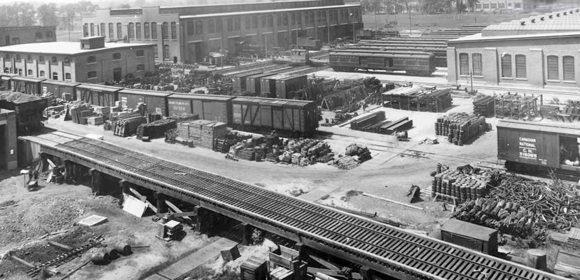
While shopping at the new Longo’s on Laird, it’s hard not to notice that you’re in a restored heritage building.
The store, in fact, used to be an old locomotive shop for the former Canadian Northern Railway. What you might not realize is how closely connected the site is to the founding of Leaside.
Leaside was a real estate venture of two Toronto entrepreneurs, Sir William Mackenzie and Sir Donald Mann, who established the Canadian Northern Railway (CNoR) in 1899. As they grew their railway “empire,” CNoR at one point owned not just steam and electric railways, but a network of streetcars, hotels, mines and even a steamship company.
At the height of their success the two business partners faced a challenge—they needed more terminal facilities to repair and store their trains. So they bought 1,000 acres of farmland in and beyond the area we now know as Leaside. This would give them space so they could build storage and other facilities, e.g. offices, repair shops, marshalling yards, even employee housing.
A landscape architect from Montreal was hired to design the town and the community, of course, became incorporated as the Town of Leaside in 1913. The dream of a large terminal, however, never fully materialized.
By 1919 the two faced financial trouble and the CNoR was absorbed into the new Canadian National Railway. When the Leaside yards and repair shops were completed in 1920 they were almost redundant (especially after the Spadina yards were opened seven years later).
They were closed in the 1930s and the locomotive repair building eventually purchased by the ES&A Robinson company, which made packaging materials.
ES&A changed owners a couple of times, known by many in the neigbourhood first as Norampac, then Winpak.
Vacated in 2005, the site sat vacant and vandalized until it was bought by a car dealership, then sold to First Capital for Leaside Village.
Moving into the restored railway building held special meaning for Anthony Longo, who opened his 25th store on the site late last August.
“We love its historical significance,” he says. “ And we’re proud of the way in which the designers transformed a 1919 building into a modern supermarket, but still keeping the character. It creates a real market feel.”
Restoring and refurbishing an older building had its challenges, especially when it came to the 40-foot wooden ceiling, caked in dirt, smoke and dust.
“The project had some surprises,” he notes. “For example, it took a lot longer to clean the original wood ceiling than expected, adding four weeks to the project and delaying the opening.
“The result,” he says, “was well worth it.”
Longo’s is a family business success story. Anthony is the son of one of the original founders, his father and two uncles who set up their first family-run store at Yonge and Castlefield in 1956. Today, 14 members of the family still work in the business.
Making the most of the inside
The challenge when redeveloping the Longo’s building and accompanying site was how to better feature the heritage building.
The Leaside Village proposal was brought before the City of Toronto’s Design Review Panel for review and analysis in accordance with a process reserved for the city’s most significant development projects.
Comprised of experts in areas such as architecture, engineering and city planning, the volunteer board was invited to provide direction for featuring Longo’s building and the site.
The panel sent it back to the drawing board. Recommendations for Longo’s included mounting individual lettering on the front wall instead of erecting a single large sign, and limiting new construction on the front wall to a glass vestibule.
In addition, the panel adopted the local councillor’s recommendation that materials such as red brick and sandstone be featured in all the new buildings on the site to reflect the themes of the existing building and neighbouring vintage structures.
An optional challenge that Longo’s decided to take on voluntarily was, What can be done about the inside?
Although the outside of the old locomotive facility was designated under provincial heritage legislation, the inside (not designated) had also suffered much damage over the years with graffiti and even smoke from “camp fires”.
Longo’s paid for thorough and careful restoration of the building inside and out, including the lengthy and expensive process of cleaning the wooden ceiling and bringing it up to “food grade”.
The result has been called “amongst the most innovative in design in the GTA”.

